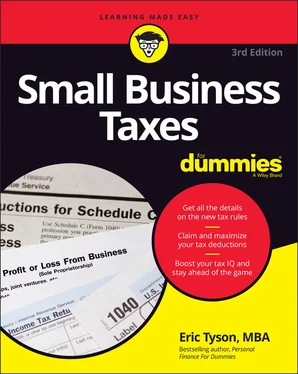Providing valued benefits: Another reason to consider particular benefits for your employees is that they’ll value them. What benefits your employees value in turn depends on your workforce’s makeup. If your employees are primarily older people nearing retirement, they’ll value a different mix of benefits, for example, than employees who are younger and single or employees with dependent children.
In this section, I discuss the most common benefits small businesses tend to offer and provide pertinent background for each. I also discuss what tax-deductible benefits are uniquely offered to corporations only.
Retirement plans are a terrific way for business owners and their employees to tax shelter (defer) a healthy portion of their earnings. Of all the benefits that a small business can offer, a retirement savings plan can be the most valuable in saving employees taxes and helping them accumulate significant savings for their own retirement.
If you don’t have employees, regularly contributing to one of these plans is generally a no-brainer. That’s because you can set up high-quality retirement plans for little or no cost.
When you have employees, the decision is a bit more complicated but is often a great idea. Self-employed people may contribute to simplified employee pension individual retirement accounts (SEP-IRAs), or SIMPLE plans. Small businesses with a number of employees can also consider 401(k) plans, and those with no employees can consider a solo 401(k) plan.
I discuss all these plans and the impact of the tax rules in detail in Chapter 3.
Many employees consider health insurance to be the most valuable benefit a company offers. In reality, it’s actually a retirement plan unless you have extensive health problems and use your health insurance a lot, which most people don’t.
Almost everyone needs health insurance (except perhaps the super-wealthy, like Bill Gates), but not everyone has it. Before Medicare, the U.S. government-provided insurance program that kicks in at age 65+, most folks obtained their health insurance through their employer. Employer-provided coverage eliminates the headache of each employee having to shop for coverage, and group coverage is usually less costly than coverage that individuals buy on their own.
 Your small business may be eligible for a tax credit by providing health insurance to your employees and their dependents if you pay for at least half that cost. To qualify for the tax credit, which amounts to 35 percent of the health insurance premiums your business pays, your company must have fewer than 25 full-time employees, and their average wages/salaries must be less than $50,000 per year. You claim the credit on IRS Form 8941, “Credit for Small Employer Health Insurance Premiums.” (It’s available at
Your small business may be eligible for a tax credit by providing health insurance to your employees and their dependents if you pay for at least half that cost. To qualify for the tax credit, which amounts to 35 percent of the health insurance premiums your business pays, your company must have fewer than 25 full-time employees, and their average wages/salaries must be less than $50,000 per year. You claim the credit on IRS Form 8941, “Credit for Small Employer Health Insurance Premiums.” (It’s available at www.irs.gov/pub/irs-pdf/f8941.pdf .) This credit is only permissible for two consecutive tax years after 2013.
The following sections list plan attributes to consider, explain the effect of recent healthcare reform, help you evaluate and buy insurance, and provide pointers on saving money on healthcare.
Looking at plan attributes
Here’s what to look for when selecting among the health insurance offerings in the marketplace. ( I mportant note: the federal legislation known formally as the Patient Protection and Affordable Care Act, discussed in the next section, impacts a number of these issues.)
Major medical coverage: A good health insurance plan covers the big potential expenses: hospitalization, physician, and ancillary charges, such as X-rays and laboratory work.
Choice of healthcare providers: Plans that allow you to use any healthcare provider you want are becoming less common and more expensive in most areas. Health maintenance organizations (HMOs) and preferred provider organizations (PPOs) are the main plans that restrict your choices. They keep costs down because they negotiate lower rates with selected providers. The main difference is that PPOs still pay the majority of your expenses if you use a provider outside their approved list. If you use a provider outside the approved list with an HMO, you typically aren’t covered at all. Although HMO and PPO plans do offer fewer choices when it comes to providers, surveys show that customer satisfaction with these plans is comparatively good.
Deductibles and co-payments: To reduce your health insurance premiums, choose a plan with the highest deductible and co-payment folks can afford. As with other insurance policies, the more you’re willing to share in the payment of your claims, the less you have to pay in premiums. Most policies have annual deductible options (such as $250, $500, $1,000, and so on) as well as co-payment options, which are typically 20 percent or so. When choosing a co-payment percentage, know that insurance plans generally set a maximum out-of-pocket limit on your annual co-payments (such as $1,000 or $2,000); the insurer covers 100 percent of any medical expenses that go over that cap. Note: Most HMO plans don’t have deductible and co-payment options. Most just charge a set amount — such as $25 — for a physician’s office visit.
Guaranteed renewability: You want a health insurance plan that keeps renewing your coverage without you having to prove continued good health. If you could guarantee good health, you wouldn’t need health insurance in the first place.
Making sense of the impact of healthcare reform
In March 2010, President Obama signed into law the Patient Protection and Affordable Care Act and the Health Care and Education Reconciliation Act. Together, these two laws enacted comprehensive healthcare reform in the United States. This mammoth legislation comprised thousands of pages of rules and regulations. This section highlights the most important portions of the legislation that you need to understand.
Now, employer group health plans (with 50 or more full-time employees) are subject to these rules:
Plans offering dependent coverage must offer coverage to adult children up to age 26. The coverage isn’t taxable to the employee or dependent.
Plans must provide preventive care without cost-sharing and must cover certain child preventive care services as recommended by the government. This rule applies only to new group health plans.
Employers must offer minimum essential coverage to full-time employees or make nondeductible payments to the government.
Plans must remove all annual dollar limits on participants’ benefit payments. They may not impose lifetime limits.
Plans must limit cost-sharing and deductibles to levels that don’t exceed those applicable to a health-savings-account-eligible, high-deductible health plan.
Plans must remove all preexisting-condition exclusions on all participants.
Plans may not have waiting periods of longer than 90 days.
Higher income taxpayers are now hit with higher tax rates on their investments as well as higher Medicare tax rates to help pay for Obamacare. Taxpayers with total taxable income above $200,000 (for a single return) or $250,000 (for a joint return) from any source are subject to a 3.8 percent tax on the lesser of the following:
Their net investment income (for example, interest, dividends, and capital gains)
The amount, if any, by which their modified adjusted gross income exceeds the dollar thresholds
Taxpayers with earned income above $200,000 (for a single return) or $250,000 (for a joint return) are subject to an additional 0.9 percent Medicare tax (in other words, rising from 1.45 percent to 2.35 percent) on wages in excess of those amounts. Employers aren’t required to match the payment of this incremental increase, which is applicable only to the employee.
Читать дальше

 Your small business may be eligible for a tax credit by providing health insurance to your employees and their dependents if you pay for at least half that cost. To qualify for the tax credit, which amounts to 35 percent of the health insurance premiums your business pays, your company must have fewer than 25 full-time employees, and their average wages/salaries must be less than $50,000 per year. You claim the credit on IRS Form 8941, “Credit for Small Employer Health Insurance Premiums.” (It’s available at
Your small business may be eligible for a tax credit by providing health insurance to your employees and their dependents if you pay for at least half that cost. To qualify for the tax credit, which amounts to 35 percent of the health insurance premiums your business pays, your company must have fewer than 25 full-time employees, and their average wages/salaries must be less than $50,000 per year. You claim the credit on IRS Form 8941, “Credit for Small Employer Health Insurance Premiums.” (It’s available at 










